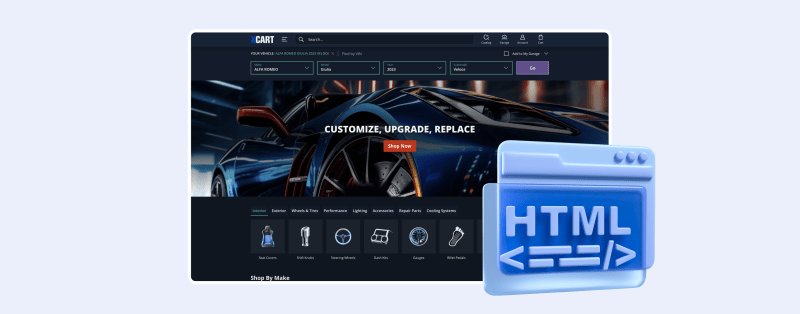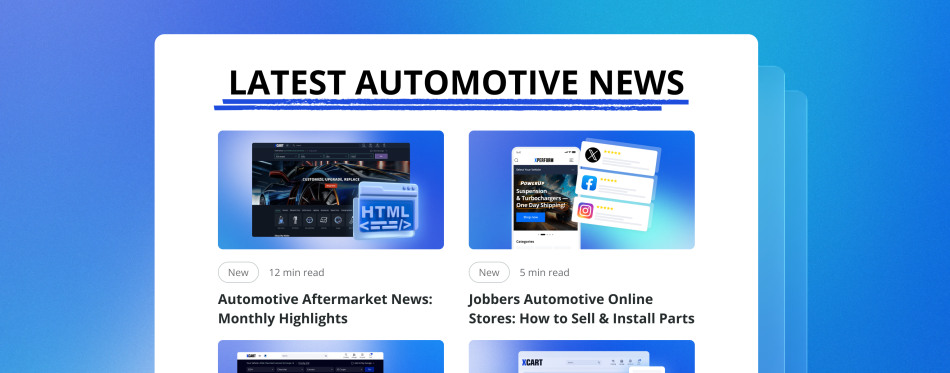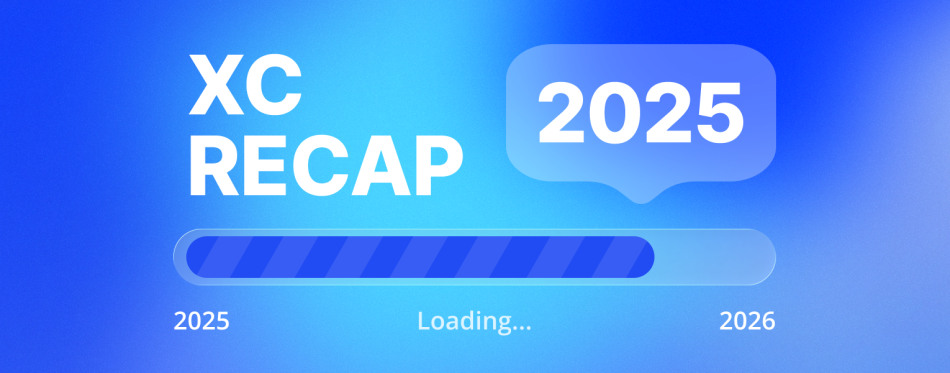Customization vs Configuration to Optimize Your Automotive eCommerce
Selling car parts online isn’t like slinging t-shirts. You’re moving inventory, but you’re also navigating fitment data, core charges, and shipping that weighs more than a small person. The software you choose to build your empire on is everything. So, you’re hunting for an eCommerce solution that won’t buckle under the sheer weight and complexity of the automotive world.
This brings us to the great digital question: customization vs configuration.
These two terms get tossed around often, but they mean different things for your business. One is about using the tools in the box, and the other is about building entirely new tools to meet specific requirements. Getting this wrong can mean stalling out while your competition laps you.
Let’s tear down these concepts and see what makes an auto parts store fire on all cylinders.
What Is Configuration?
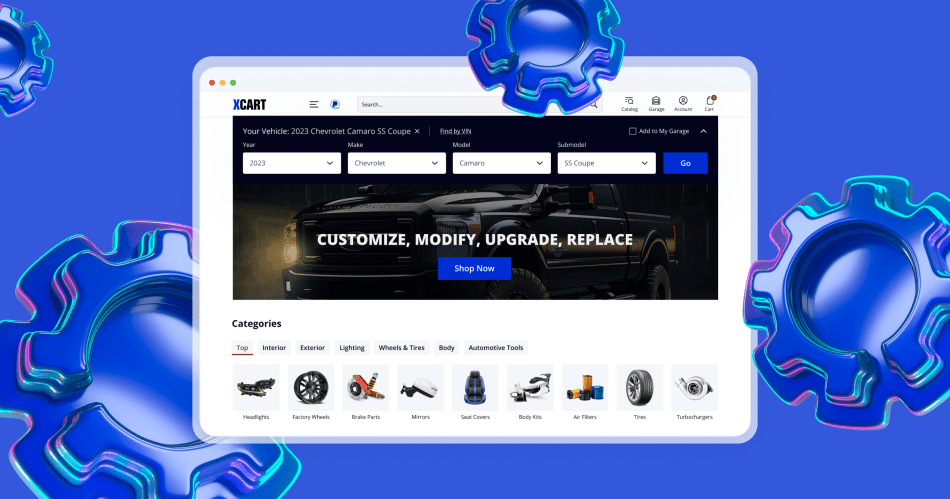
Any decent eCommerce platform, something like X-Cart, for instance, comes with a dashboard full of dials and levers (standard configuration options). That’s the configuration. It’s the things you can change without a degree in computer science. It’s using the built-in tools to bend the software to your will and business needs. No new code and functionality is written.
For an auto parts dealer, this means more than picking colors and uploading a logo; it means mission control. A robust standard configuration is your first line of defense against chaos. It lets you manage :
- Fitment data filters. A powerful out-of-the-box feature would be setting up Year/Make/Model lookups. You won’t be building the lookup from scratch, only configuring how it appears and functions in your user interface.
- Payment & shipping options. Toggling on payment gateways is standard. But what about configuring complex shipping rules for different product weights and dimensions? Setting rules for freight shipping an engine block versus standard parcel for a set of spark plugs is a configuration task.
- Core charge management. Many parts, like alternators or brake calipers, have a core charge. Your system needs to handle this extra deposit and its refund process. A good platform has a module for this that you just need to configure.
- Access levels. If you run a multi-vendor marketplace for different sellers or have different roles in your warehouse, you need to set up UI policies and permissions. Who can see sales data? Who can only manage inventory? That’s all the configuration.
- Email templates. Setting up automated emails for order confirmations is basic. But what about a template for “Your part has shipped via freight, here’s how to schedule delivery”? That’s a more specific, but still configurable, business process.
So, configuration refers to working within the provided framework. It’s usually cost-effective and fast, if we compare configuration and customization. The approach is wise for the online auto parts market, which is only growing bigger in the US alone. You can’t afford to waste time reinventing the wheel if a solid configuration will get you on the road.
But what happens when the road ends? When your specific business requirements are so unique, the standard configuration options don’t work?
What Is Customization and Custom Development?
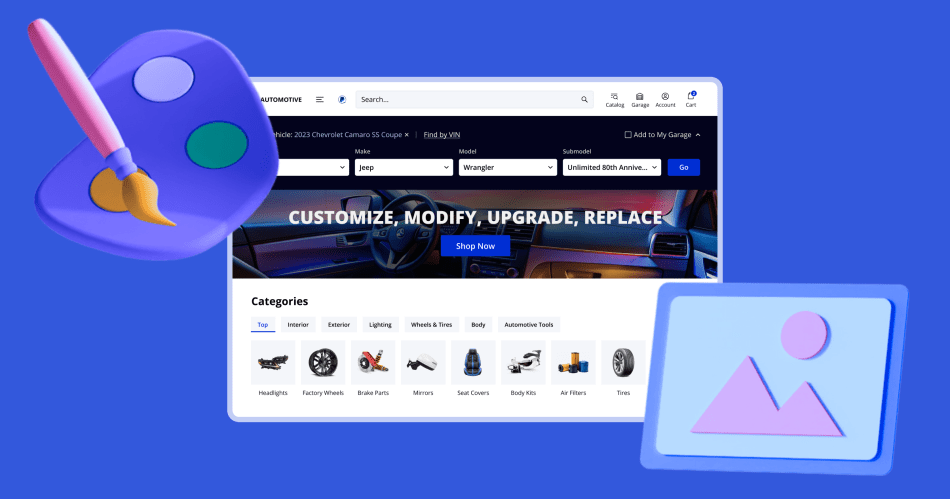
Here, things get serious. Customization is not tweaking a setting but hiring a mechanic to fabricate a whole new part for your engine. It involves writing custom code to make the software do something for your clients that it was never designed to do. This is the realm of custom eCommerce development, and it’s where you can build a truly unique competitive advantage.
When you’re staring at a problem that a pre-built addon can’t solve, you’re looking at customization. Think about the industry-specific problems in auto parts:
- ACES and PIES integration. The automotive aftermarket runs on ACES (Aftermarket Catalog Exchange Standard) and PIES (Product Information Exchange Standard) data. This is how you ensure the CV axle you’re selling actually fits a 2018 Ford F-150. If your platform doesn’t have a rock-solid native way to process these massive data files, like X-Cart with its strong compliance and security settings, you’ll need custom development to build that bridge.
- Complex bundling. You want to sell a “Complete V8 Engine Swap Kit” that includes the engine, transmission, wiring harness, and ECU, all with their own inventory and fitment rules? An off-the-shelf bundling tool might choke. A customization can create a system that pulls these disparate parts into a single and sellable unit with its own SKU and price.
- Dynamic shipping logic. Some parts are just plain weird to ship. An airbag is legally a hazardous material. A catalytic converter might have shipping restrictions in certain states, like California. A custom solution can query a live database of shipping regulations and present the correct, legal shipping options at checkout, protecting you from massive fines. That’s a specific business process and workflows that demand new code.
- Connecting to obscure ERPs. Maybe your entire warehouse runs on a 20-year-old enterprise software that’s been heavily modified. You’re not migrating off it. You’ll need to pay for custom development to get your shiny new eCommerce site to talk to your ancient, but essential backend system.
Platforms like X-Cart are great helpers here because they are built to be tinkered with. While they offer a galaxy of configuration options, they don’t lock developers out. This allows for deep customization when a business’s specific needs push beyond the ordinary. You can modify the platform at a fundamental level.
The Breakdown: Configuration vs Customization
Deciding which path to take is a major crossroad for decision makers, and usually a balance at different levels: budget, risk, and ambition.
| Strengths | Hidden Risks | |
| Customization | It carves out a unique space for you. Your store does things no other application can, matching your specific business requirements perfectly. | This path is paved with money. Excessive customization can drain your budget fast. You’re paying for development and ongoing maintenance. Every time the core platform updates, your custom code might break, leading to downtime and more developer bills. The complexity can become a monster. Tip: Look for platforms that you can customize and that come with a dedicated in-house team behind the product. Their updates won’t break anything because they know their solution to 100%. |
| Configuration | It’s cheaper, faster, and safer. Using built-in tools and pre-vetted addons from a service catalog carries far less risk. You don’t need in-house developers, just a smart person who can read a manual. It’s a cost-effective way to get 90% of the way there. | That last 10% can be a killer. An addon might almost do what you need, but not quite. You may find your growth is capped by the limitations of the standard features, forcing a painful migration to a new solution later. You’re limited to what the vendor provides, unless the platform gives you all the code, ownership, and dedicated support. |
The Finish Line: Configuration and Customization
The debate isn’t really configuration vs customization. That’s the wrong way to look at it because they aren’t opponents but a sequence: one flows into the other. Leaning only on configuration might leave you stuck in the slow lane, unable to adapt to the unique demands of the auto parts market. Going full-throttle on over customization from day one is a fantastic way to run out of gas before you even finish the first lap.
The real winning move is to choose a customizable eCommerce platform architected for both. You need a system that is profoundly configurable for all the standard things (the day-to-day operations). But it must also have open architecture and support for deep customization when you inevitably encounter a challenge unique to your organization.
A solution like X-Cart, with its long history and in-house expertise, provides that balance. You can start with powerful configurations and, when you’re ready to make a difference and solve a truly unique problem, be it integrating with a proprietary inventory system or building a revolutionary fitment tool, you have the option and the support to build it. You configure what you can, and you customize what you must. That’s how you build a machine that lasts.
Along with efficiently configurable tools and robust opportunities for customization, X-Cart has a professional team of web developers in-house. Our team is always ready to guide you on whether the required integration is worth investing in and recommend an ultimately helpful solution.
Want an auto parts store that’s both configurable and customizable?
Frequently Asked Questions
1. I’m just launching my store for classic Ford Mustang parts. Do I really need to worry about ‘customization’ right now, or can I just get by with the standard stuff?
Great question, and honestly, for most people starting out, the answer is no. You absolutely do not need to dive into the deep end of custom development on day one.
You wouldn’t bolt a supercharger onto a car before you’ve even checked the tire pressure, right? Your first job is to master configuration. Use the built-in tools of a solid platform like X-Cart to get your fundamentals locked down. Focus on configuring your Year/Make/Model search so it’s perfect for classic Mustangs. Set up your shipping rules for carburetors versus fenders. Nail down your payment options.
Get the business running on the tools you already have. Customization is what you plan for when your business grows so much that you have a unique problem, like building a special tool to track the provenance of rare Shelby parts, that a standard feature can’t solve. Start with configuration because it’s smarter, cheaper, and gets you racing faster.
2. You mentioned ‘over customization’ can be a money pit. Can you give me a real example of how that actually happens to a parts seller?
Absolutely. It’s a trap that looks like a brilliant shortcut at first.
Imagine you sell oversized truck tires and lift kits, and the shipping is a nightmare. You decide the platform’s built-in shipping tools aren’t quite perfect, so you pay a freelancer $10,000 to write a completely custom code solution from scratch. It connects to three different freight carriers and works beautifully. For a while.
Six months later, your eCommerce platform pushes a critical security and performance update. Your custom shipping code was never designed for this new version. It shatters. Suddenly, no one can check out. Your store is literally unable to process an order for a $3,000 lift kit. You’re dead in the water, losing money every hour. Now you have to pay that developer again, at emergency rates, to drop everything and fix their code. This cycle of breaking and fixing after every platform update becomes a constant and expensive headache.
That’s the hidden cost of ongoing maintenance for a custom solution that could have been avoided by using a more robust and configurable tool in the first place with a dedicated in-house team behind it.
3. If I have to save my money for one big ‘customization’ project in the next year or two, what gives me the most bang for my buck?
Hands down, the smartest money is spent on perfecting your fitment data management. Everything else is secondary.
Fitment (making sure the part fits the car) is the heart of the auto parts business. It’s the number one reason for costly returns, angry phone calls, and destroyed customer trust. While a basic Year/Make/Model lookup is a configuration task, a bulletproof fitment system is often a custom development project.
This means investing in a deep integration with an industry-standard data provider for ACES and PIES data. It’s a project that ensures when a customer says they have a 2021 Jeep Wrangler Rubicon, they only see parts that are 100% guaranteed to fit. When this works flawlessly, your conversion rate climbs, your return rate plummets, and you become the go-to source that “gets it right.” It’s the single biggest competitive advantage you can build for yourself.
The best news, however, is that you don’t need to customize such basic automotive things at a big price if you’re starting out with an automotive-first platform like X-Cart. With it, you’ll need customizations for more sophisticated things like ultra sleek design, AR virtual showroom (except for wheels and tires, because X-Cart already has one!), and things like this.
About the author

